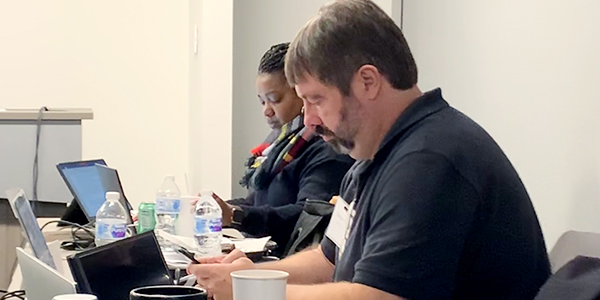NERC has extended voting on Project 2015-09 (Establish and Communicate System Operating Limits) to 8 p.m. ET Aug. 26 because six nonbinding polls failed to reach a quorum. The original deadline was Aug. 3.
The standard drafting team on the project met Thursday to review comments received to date. Among the most common was a concern that two adjacent reliability coordinators, transmission operators or regional entities could have disagreements in real-time about system operating limits (SOLs) and exceedances. Eleven commenters supported aligning Facilities Design, Connections and Maintenance (FAC) standards and treatment of SOLs with the revised Transmission Operations (TOP) and Interconnection Reliability Operations and Coordination (IRO) standards.

Dean LaForest, ISO-NE | © ERO Insider
There were also complaints that the proposed 12-month implementation period is too short, with 10 commenters calling for the window to be extended to at least 24 months and two suggesting a 30-month time frame. SDT Chair Dean LaForest, of ISO-NE, called this perspective “reasonable” and suggested that the team consider revising the requirement.
“This was something espoused by many folks: that … if you are making the types and the magnitude of changes that are being made with FAC-011 … they need to put in software [and] other means of checking and capturing data to be able to show compliance, and they could not necessarily do that within 12 months,” he said.
Some commenters recommended a change to FAC-011-4 R6.4, which states that “planned manual load shedding is acceptable only after all available system adjustments have been made.” A comment from the Midwest Reliability Organization’s NERC Standards Review Forum (NSRF), which was endorsed by several other respondents, recommended changing the word “made” to “assessed” to ensure that utilities are not unnecessarily burdened.
“We don’t believe it is the SDT’s intention to require every system adjustment to actually be implemented in a study or model prior to determining that manual load shed is the best planned response,” the NSRF said. “We believe the intent is to ensure all available adjustments have been appropriately assessed before deciding on the solution of last resort.”
Further Contentions over Clarity
A frequent topic among commenters was a desire for more clearly defined and “results-based” thresholds for SOL exceedance determination. John Allen, of City Utilities of Springfield (Mo.), requested that the standard “define a clear and measurable expected outcome for all registered entities,” warning that it would otherwise be difficult to enforce. Rachel Coyne of Texas Reliability Entity also asked for “additional clarity,” particularly with regard to the duration of SOL exceedances as defined in FAC-011-4 R6.
In response to these requests, LaForest acknowledged utilities’ concerns that being given flexibility to determine their SOL exceedances could lead to mistakenly overstepping boundaries. However, he reminded participants that the team had spent considerable effort arriving at the current, “finely tuned balance in terms of what’s concrete … and what’s flexible” — a reference to the nearly five-year development process — and said changing that balance at this point could lead to objections from elsewhere in the industry.
“Our prior ballots were much more black-and-white and less flexible, and I think that was part of the reason why, at least with respect to FAC-011, they failed to garner two-thirds support among industry commenters,” LaForest said. “So, I’m not sure there’s much we can do specifically with this particular comment to help or accommodate the folks who supported it.”
Logging Language Gains Approval
Commenters were generally favorable toward the SDT’s addition of a seventh requirement to FAC-011-4 providing “a risk-based approach for determining how SOL exceedances are identified and … communicated,” which the team provided in response to industry concerns about compliance burdens posed by the previous version’s logging requirements. SDT members noted that of 65 votes received so far, just 14 opposed the proposed requirement R7, while 50 supported it.
Most “no” votes did not raise major objections. For instance, ERCOT’s Stephen Solis, who participated in the conference call, told the team that the grid operator’s opposition was based solely on a desire to clarify the meaning of the word “communicated” in R7. Solis emphasized that ERCOT plans to change its vote if the requirement is revised to explicitly include electronic communications as an acceptable means of alerting RCs to SOL exceedances.
Other commenters made clear that their votes were based more on their objections to FAC-011-4 as a whole. One of these skeptics was Jack Stamper of Clark Public Utilities, who called the standard “administratively burdensome on small entities” for giving utilities no ability to “address technical problems with the RC-established SOLs.” Stamper said the standard should require RCs to accept and respond to feedback from registered entities on SOLs.
Cain Braveheart of the Bonneville Power Administration agreed with the requirement in principle but felt that the FAC standards were the wrong place for it. Instead, Braveheart favored relocating the documentation language to IRO-010-2 (Reliability Coordinator Data Specification and Collection) and moving the communication requirement to TOP-001-4 (Transmission Operations).



